Study on the Structural Characteristics of Bulb Tubular Pumps Based on Fluid–Structure Interaction
Abstract
1. Introduction
2. Materials and Methods
2.1. Numerical Calculation Methods
2.1.1. Flow Control Equations and Turbulence Model
2.1.2. Finite Element Analysis and Fluid Structure Coupling Theory
2.2. Model and Mesh Generation
2.2.1. Boundary Condition Settings
2.2.2. Rotor System Model and Computational Setup
2.2.3. Pump Casing and Internal Support Model and Computational Setup
2.2.4. Model Experiment
3. Results and Discussions
3.1. FSI and Modal Analysis on the Rotor System
3.2. Transient Structural Characteristics of the Impeller
3.3. Fluid–Structure Interaction Analysis of Pump Casing and Support Components
4. Conclusions
Author Contributions
Funding
Data Availability Statement
Conflicts of Interest
Nomenclature
| The density of water, kg/m3 | |
| The specific heat capacity of the fluid | |
| The components of the velocity vector in the respective directions | |
| The components of the velocity vector in the respective directions | |
| The components of the velocity vector in the respective directions | |
| T | The fluid temperature |
| k | The thermal conductivity |
| The heat generated due to viscous dissipation | |
| The turbulence production term | |
| The turbulent viscosity | |
| Model constants | |
| Model constants | |
| Model constants | |
| Model constants | |
| Model constants | |
| D | The diameter of the impeller: mm |
| Q | The flowrate of the pump, m3/s |
| Qd | The design flowrate of the pump, m3/s |
| Poisson ratio | |
| Blade tip clearance | |
| H | The head of the pump, m |
| Efficiency, % |
References
- Sun, L.; Pan, Q.; Zhang, D.; Zhao, R.; van Esch, B.B. Numerical study of the energy loss in the bulb tubular pump system focusing on the off-design conditions based on combined energy analysis methods. Energy 2022, 258, 124794. [Google Scholar] [CrossRef]
- Liu, X.; Xu, F.; Cheng, L.; Pan, W.; Jiao, W. Stress characteristics analysis of vertical bi-directional flow channel axial pump blades based on fluid–structure coupling. Machines 2022, 10, 368. [Google Scholar] [CrossRef]
- Zhang, L.; Guo, Y.; Wang, W. Large eddy simulation of turbulent flow in a true 3D Francis hydro turbine passage with dynamical fluid–structure interaction. Int. J. Numer. Methods Fluids 2007, 54, 517–541. [Google Scholar] [CrossRef]
- Campbell, R.L.; Paterson, E.G. Fluid–structure interaction analysis of flexible turbomachinery. J. Fluids Struct. 2011, 27, 1376–1391. [Google Scholar] [CrossRef]
- Zhang, L.; Guo, Y.; Wang, W. FEM simulation of turbulent flow in a turbine blade passage with dynamical fluid–structure interaction. Int. J. Numer. Methods Fluids 2009, 61, 1299–1330. [Google Scholar] [CrossRef]
- Cheng, K.; Li, S.; Cheng, L.; Sun, T.; Zhang, B.; Jiao, W. Experiment on influence of blade angle on hydraulic characteristics of the shaft tubular pumping device. Processes 2022, 10, 590. [Google Scholar] [CrossRef]
- Shi, L.; Zhu, J.; Wang, L.; Chu, S.; Tang, F.; Jin, Y. Comparative analysis of strength and modal characteristics of a full tubular pump and an axial flow pump impellers based on fluid-structure interaction. Energies 2021, 14, 6395. [Google Scholar] [CrossRef]
- Pei, J.; Meng, F.; Li, Y.; Yuan, S.; Chen, J. Fluid–structure coupling analysis of deformation and stress in impeller of an axial-flow pump with two-way passage. Adv. Mech. Eng. 2016, 8, 168781401664626. [Google Scholar] [CrossRef]
- Kan, K.; Zheng, Y.; Fu, S.; Liu, H.; Yang, C.; Zhang, X. Dynamic stress of impeller blade of shaft extension tubular pump device based on bidirectional fluid-structure interaction. J. Mech. Sci. Technol. 2017, 31, 1561–1568. [Google Scholar] [CrossRef]
- Zhang, L.; Wang, S.; Yin, G.; Guan, C. Fluid–structure interaction analysis of fluid pressure pulsation and structural vibration features in a vertical axial pump. Adv. Mech. Eng. 2019, 11, 168781401982858. [Google Scholar] [CrossRef]
- Meng, F.; Yuan, S.; Li, Y. Fluid–structure coupling analysis of impeller in unstable region for a reversible axial-flow pump device. Adv. Mech. Eng. 2018, 10, 168781401775176. [Google Scholar] [CrossRef]
- Zhao, F.F.; Adu-Poku, K.A.; Xu, Z.X.; Xu, R.H.; Zhang, H.; Zhang, F. Structural dynamic characteristics analysis of a mixed-flow pump based on fluid–structure coupling. AIP Adv. 2024, 14, 015256. [Google Scholar] [CrossRef]
- Shi, L.; Wu, C.; Wang, L.; Xu, T.; Jiang, Y.; Chai, Y.; Zhu, J. Influence of blade angle deviation on the hydraulic performance and structural characteristics of S-Type front shaft extension tubular pump Device. Processes 2022, 10, 328. [Google Scholar] [CrossRef]
- Wang, S.; Zhang, L.; Yin, G. Numerical investigation of the FSI characteristics in a tubular pump. Math. Probl. Eng. 2017, 2017, 7897614. [Google Scholar] [CrossRef]
- Li, H.; Cai, Z.; Zheng, Y.; Feng, J.; Xu, H.; Chen, H.; Binama, M.; Kan, K. Investigation of structural strength and fatigue life of rotor system of a vertical axial-flow pump under full operating conditions. Water 2023, 15, 3041. [Google Scholar] [CrossRef]
- Bai, Y.; Wu, D. Study on fatigue characteristics of axial-flow pump based on two-way fluid–structure coupling. Energies 2022, 15, 8965. [Google Scholar] [CrossRef]
- Zhang, D.; Pan, D.; Xu, Y.; Shao, P.; Wang, G. Numerical investigation of blade dynamic characteristics in an axial flow pump. Therm. Sci. 2013, 17, 1511–1514. [Google Scholar] [CrossRef]
- Trivedi, C.; Cervantes, M.J. Fluid-structure interactions in francis turbines: A perspective review. Renew. Sustain. Energy Rev. 2017, 68, 87–101. [Google Scholar] [CrossRef]
- Hu, F.F.; Chen, T.; Wu, D.Z.; Wang, L.Q. Computation of stress distribution in a mixed flow pump based on fluid-structure interaction analysis. In IOP Conference Series: Materials Science and Engineering; IOP Publishing: Bristol, UK, 2013; Volume 52, p. 022035. [Google Scholar]
- Deng, X.; Gates, H.; Weaver, B.; Wood, H.; Fittro, R. Turbulence input parameters correction methodology in water lubricated thrust bearings. In Proceedings of the American Society of Mechanical Engineers 2018, Oslo, Norway, 11–15 June 2018; Volume 7, p. V07BT34A019. [Google Scholar]
- Xu, Z.; Zhao, F.; Liu, J.; Zhang, F.; Zhang, J.; Song, M. Investigation of flow-induced noise characteristics in the oblique flow pump. Processes 2022, 10, 2221. [Google Scholar] [CrossRef]
- Birajdar, R.; Keste, A. Prediction of flow-induced vibrations due to impeller hydraulic unbalance in vertical turbine pumps using one-way fluid−structure interaction. J. Vib. Eng. Technol. 2020, 8, 417–430. [Google Scholar] [CrossRef]
- Pei, J.; Yuan, S.; Yuan, J. Fluid-structure coupling effects on periodically transient flow of a single-blade sewage centrifugal pump. J. Mech. Sci. Technol. 2013, 27, 2015–2023. [Google Scholar] [CrossRef]
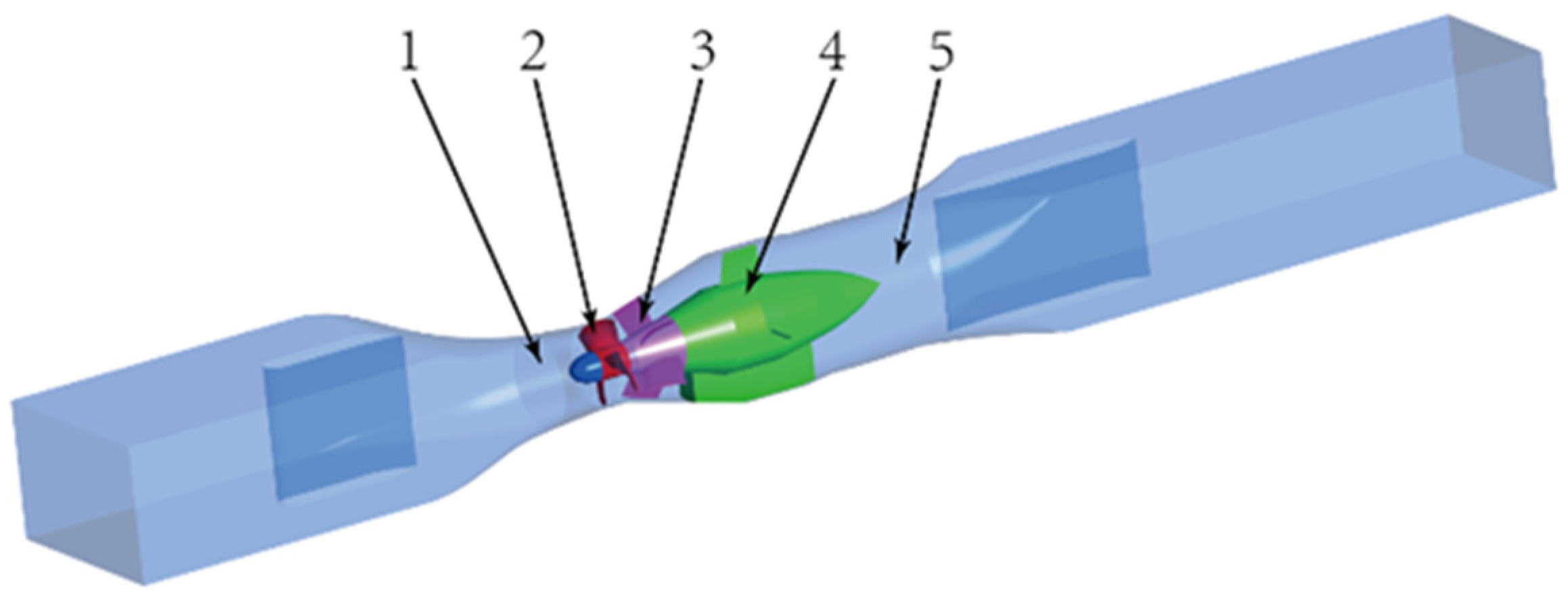

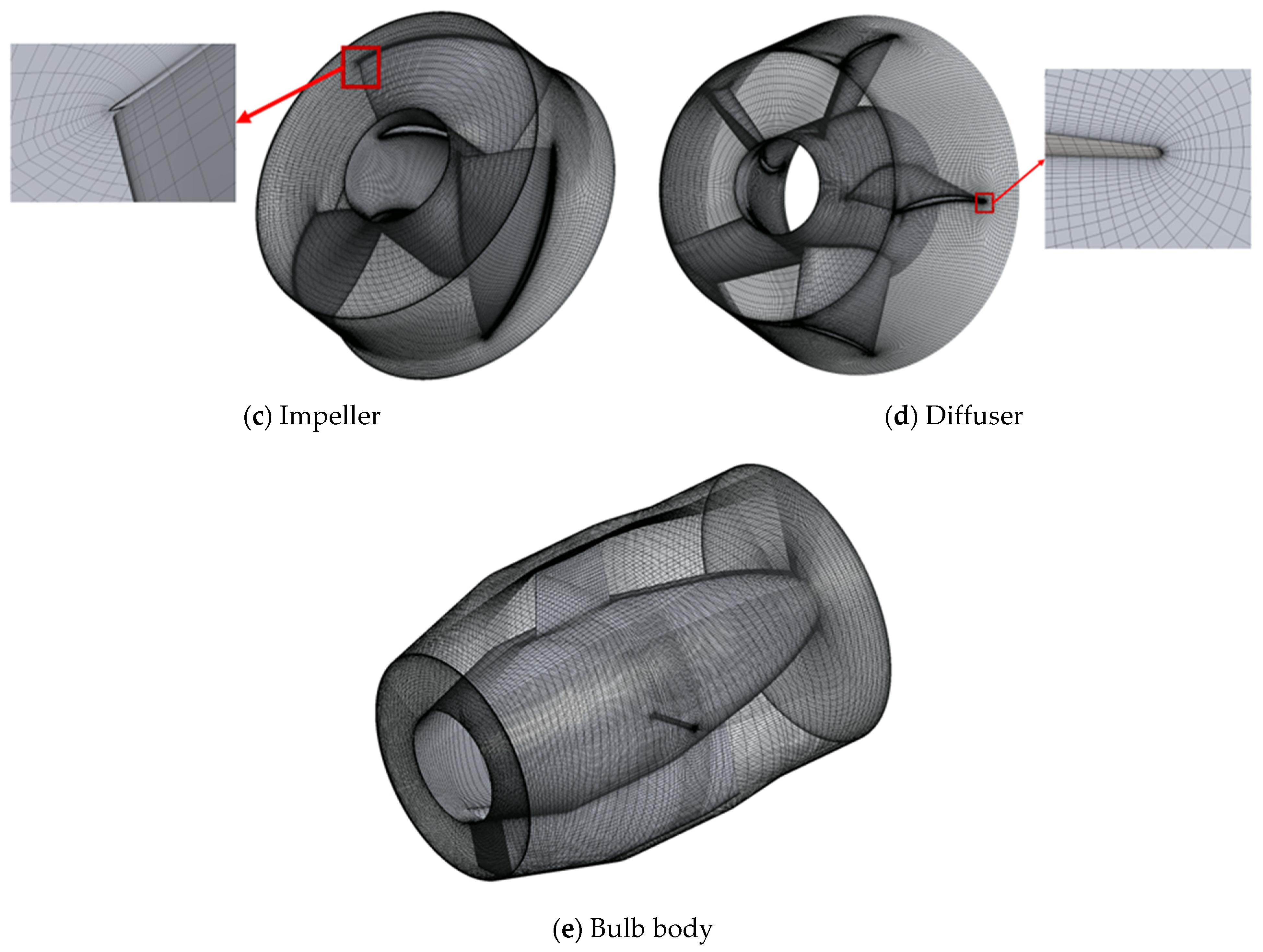
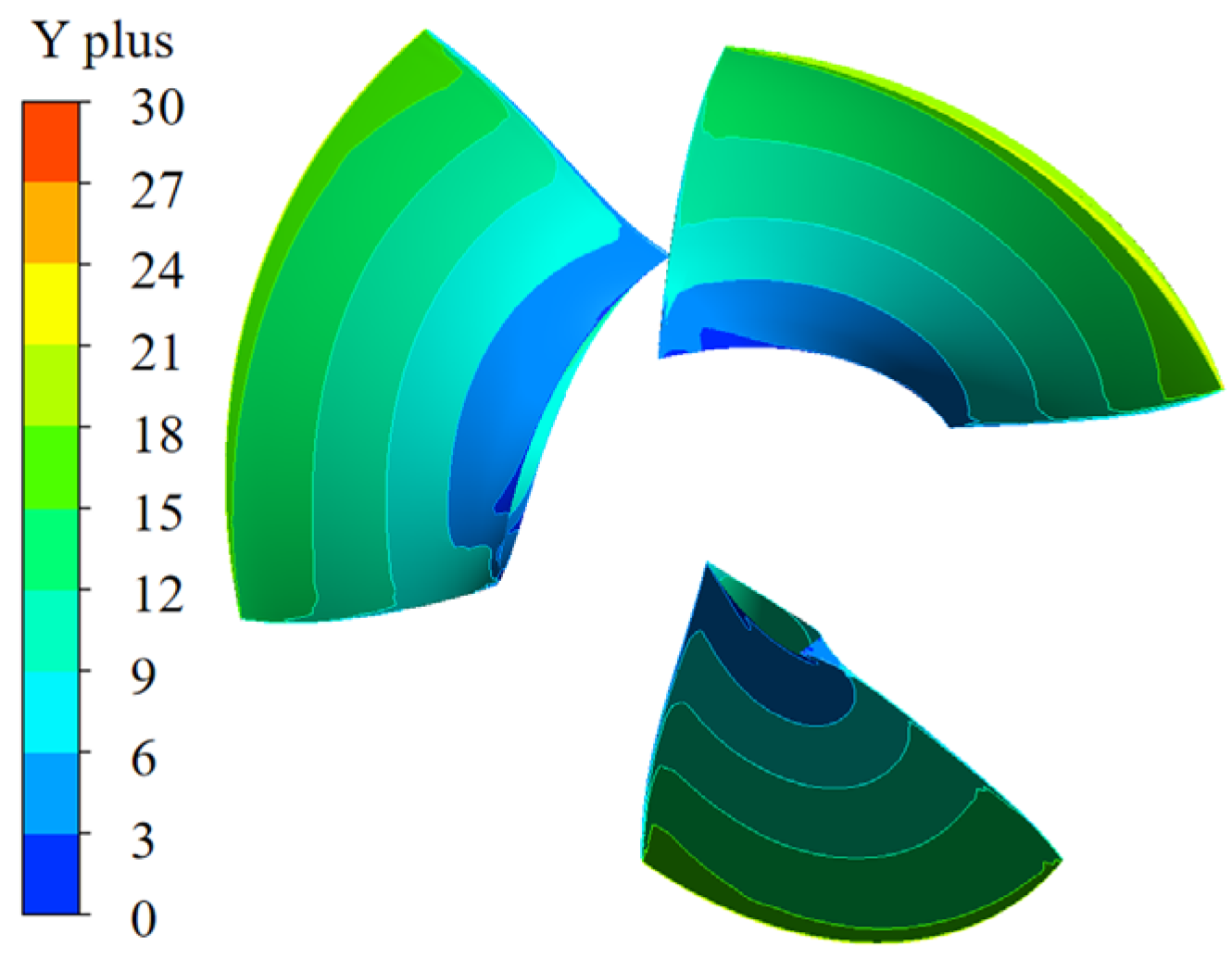


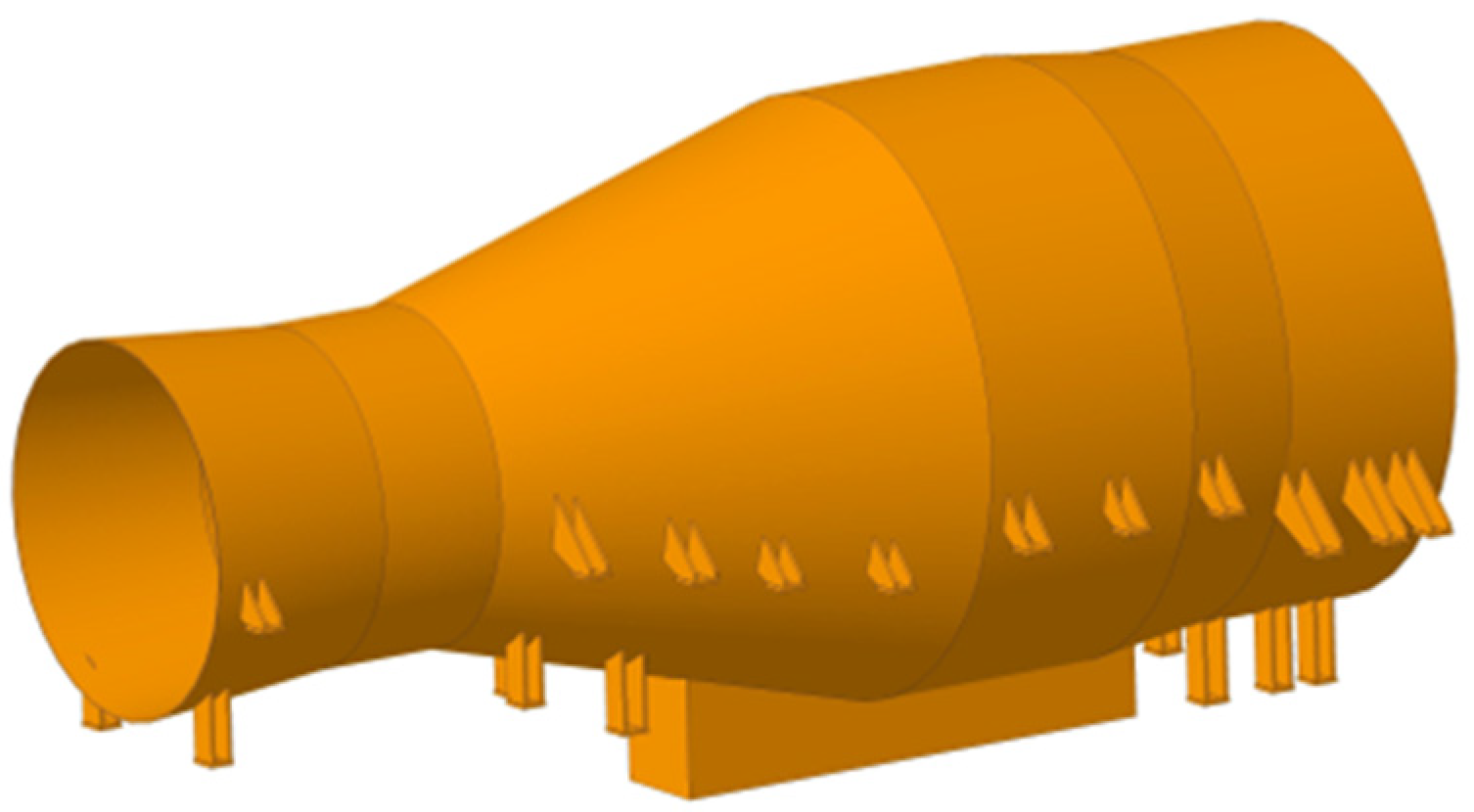
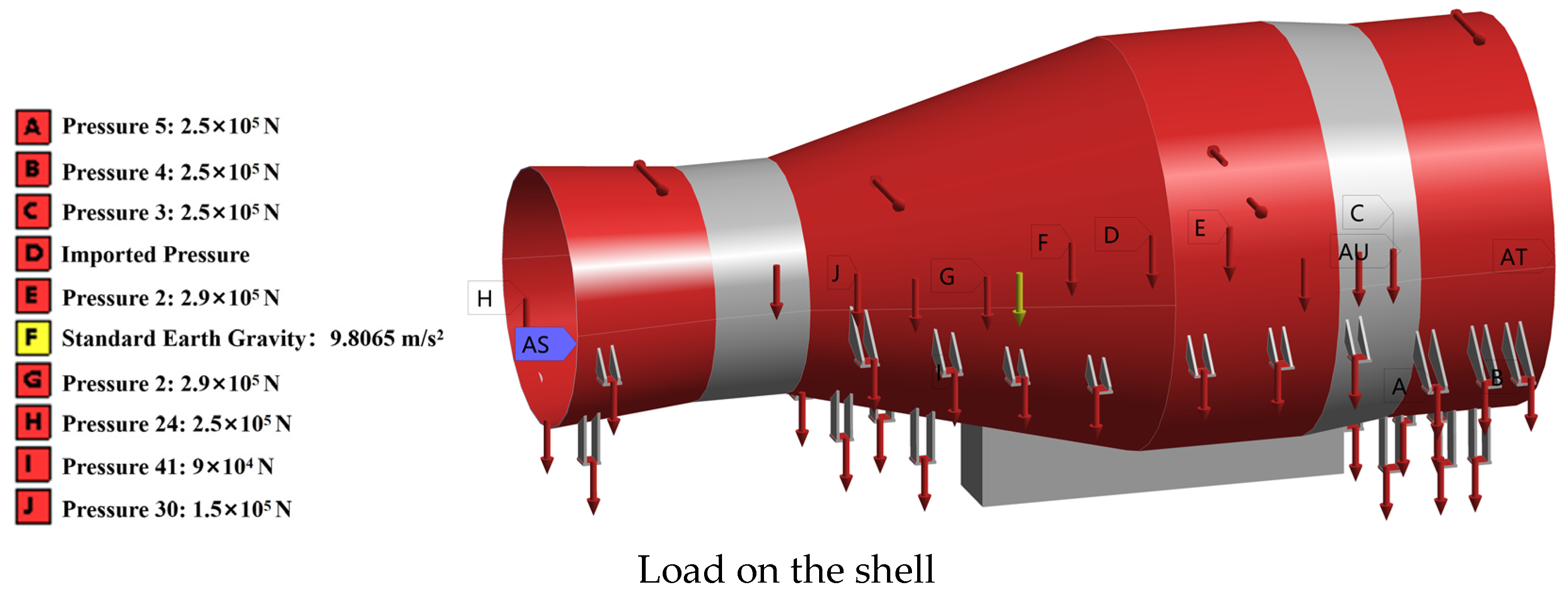
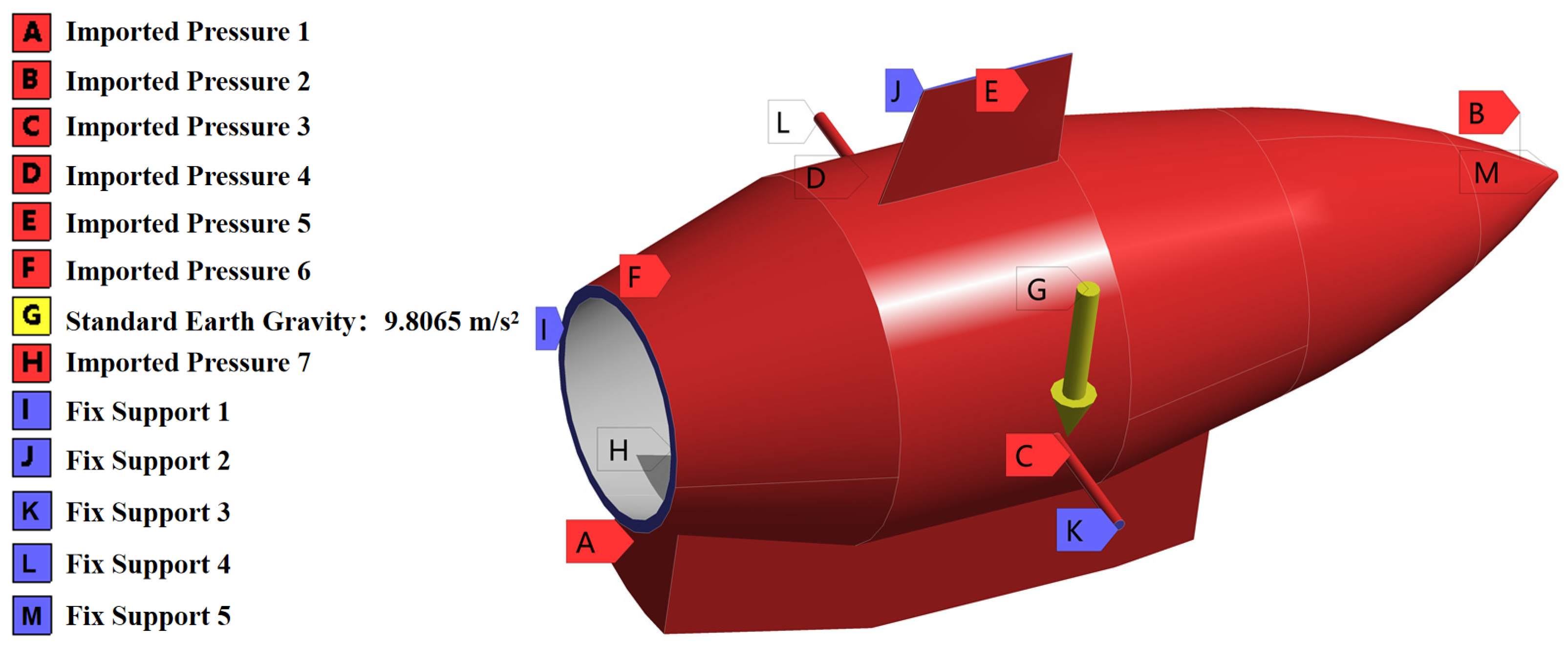
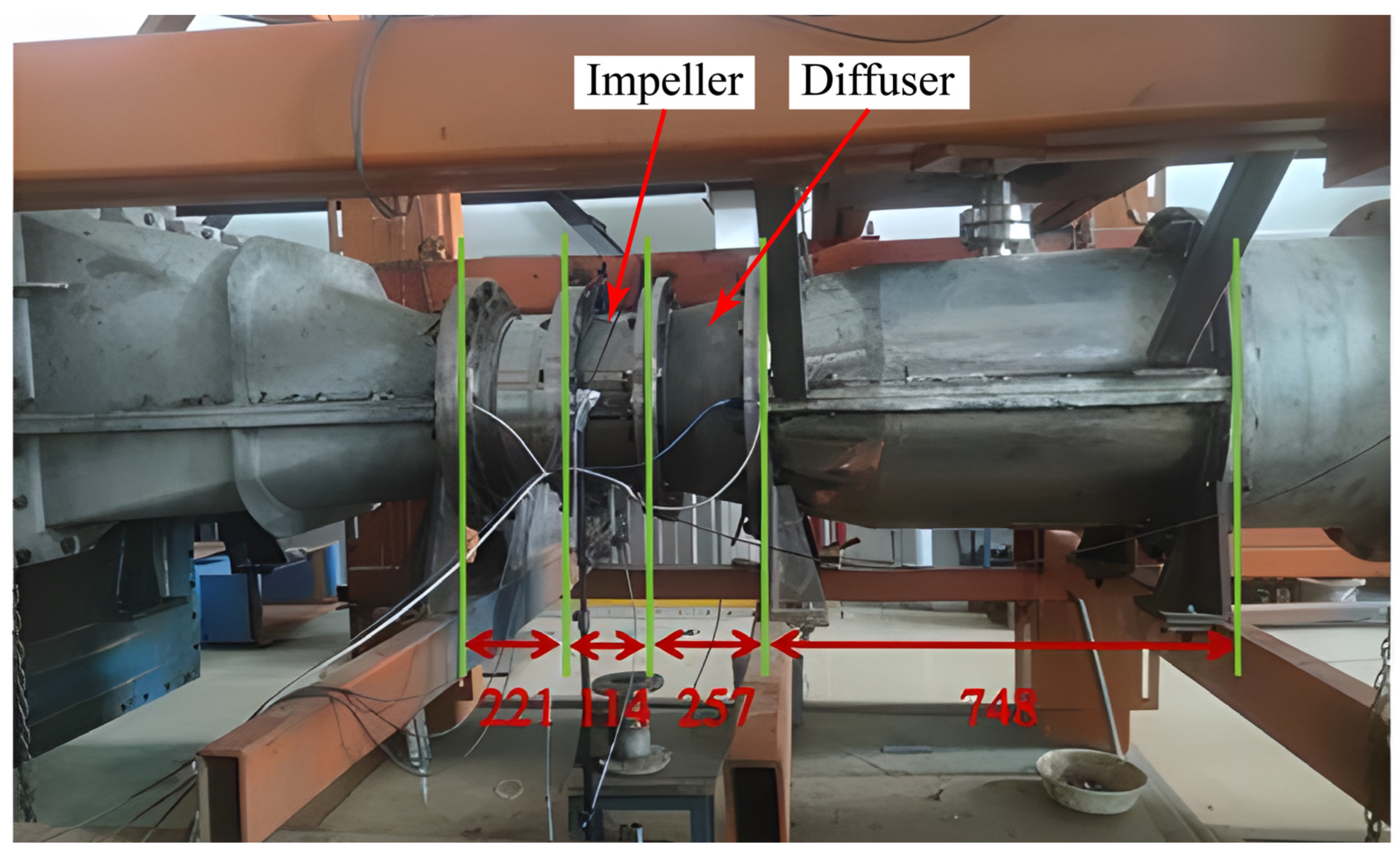
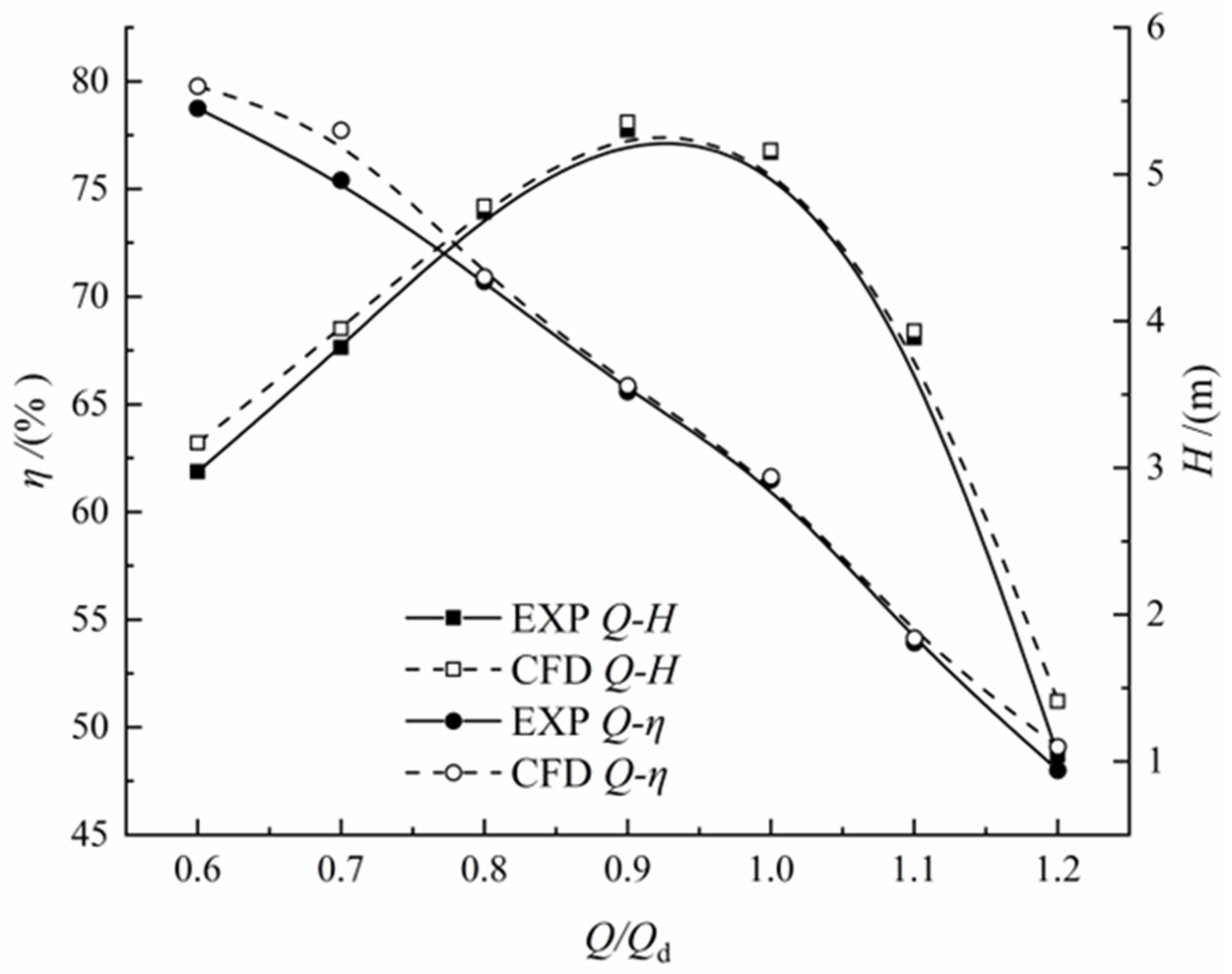
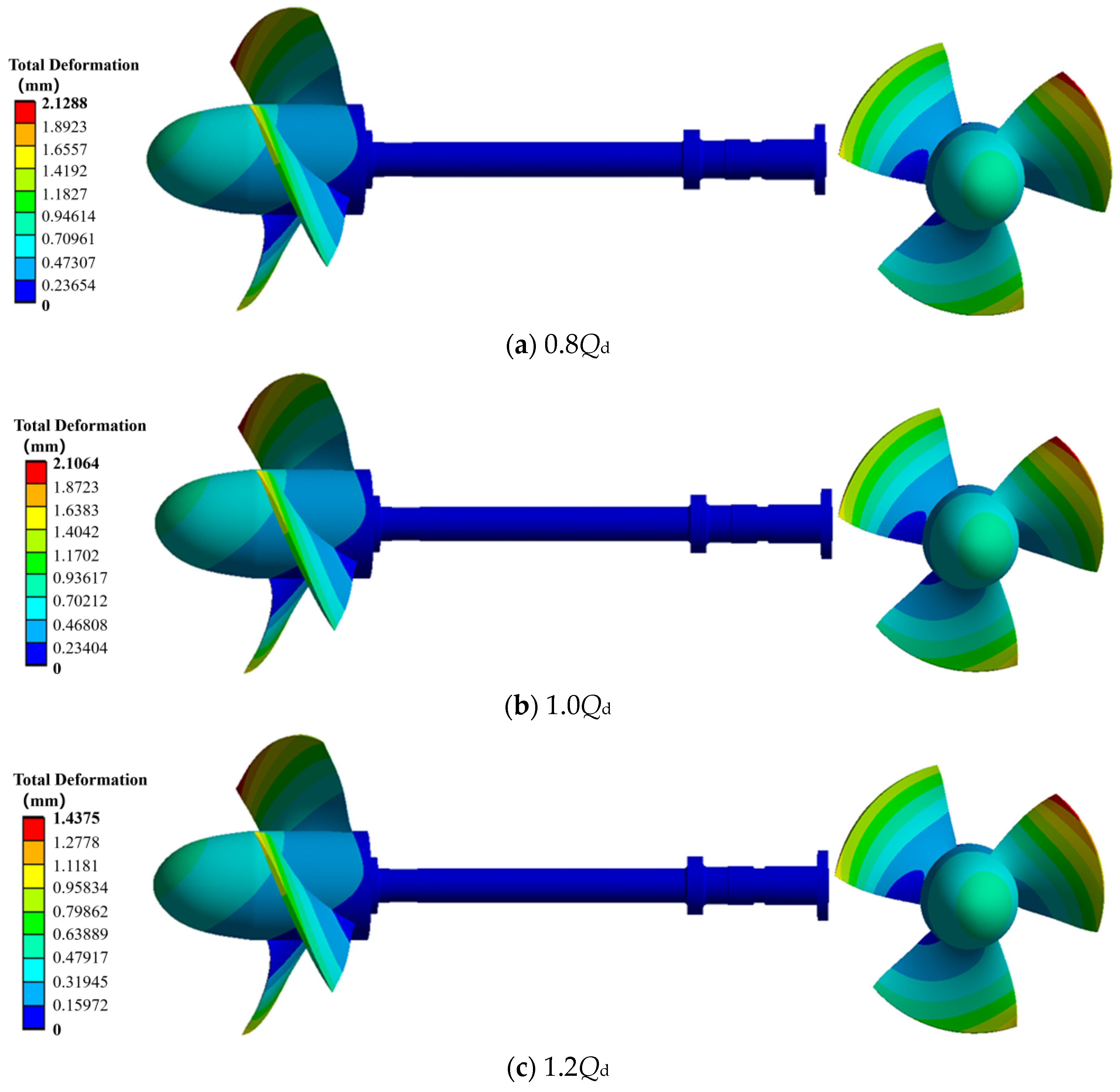
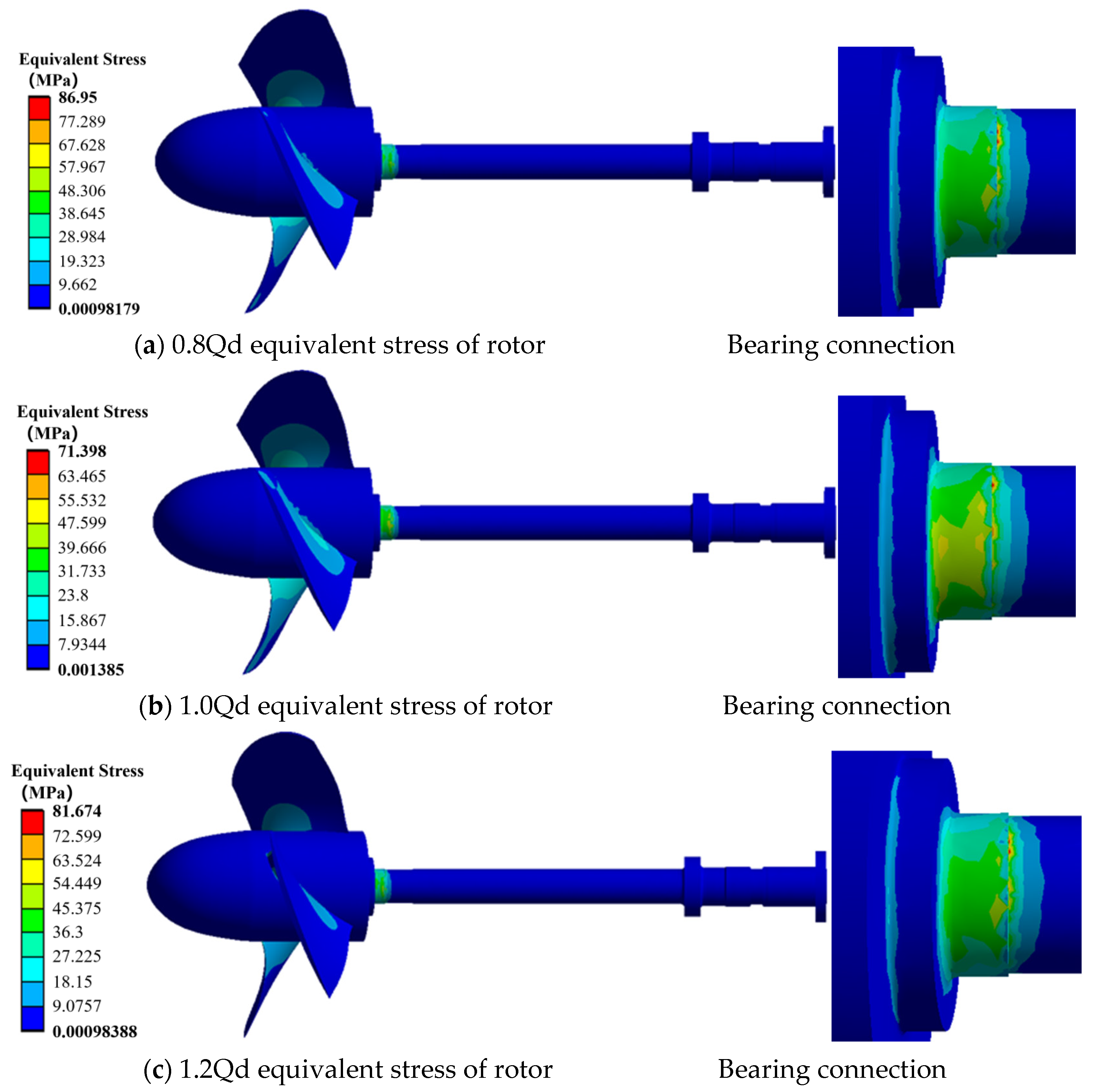



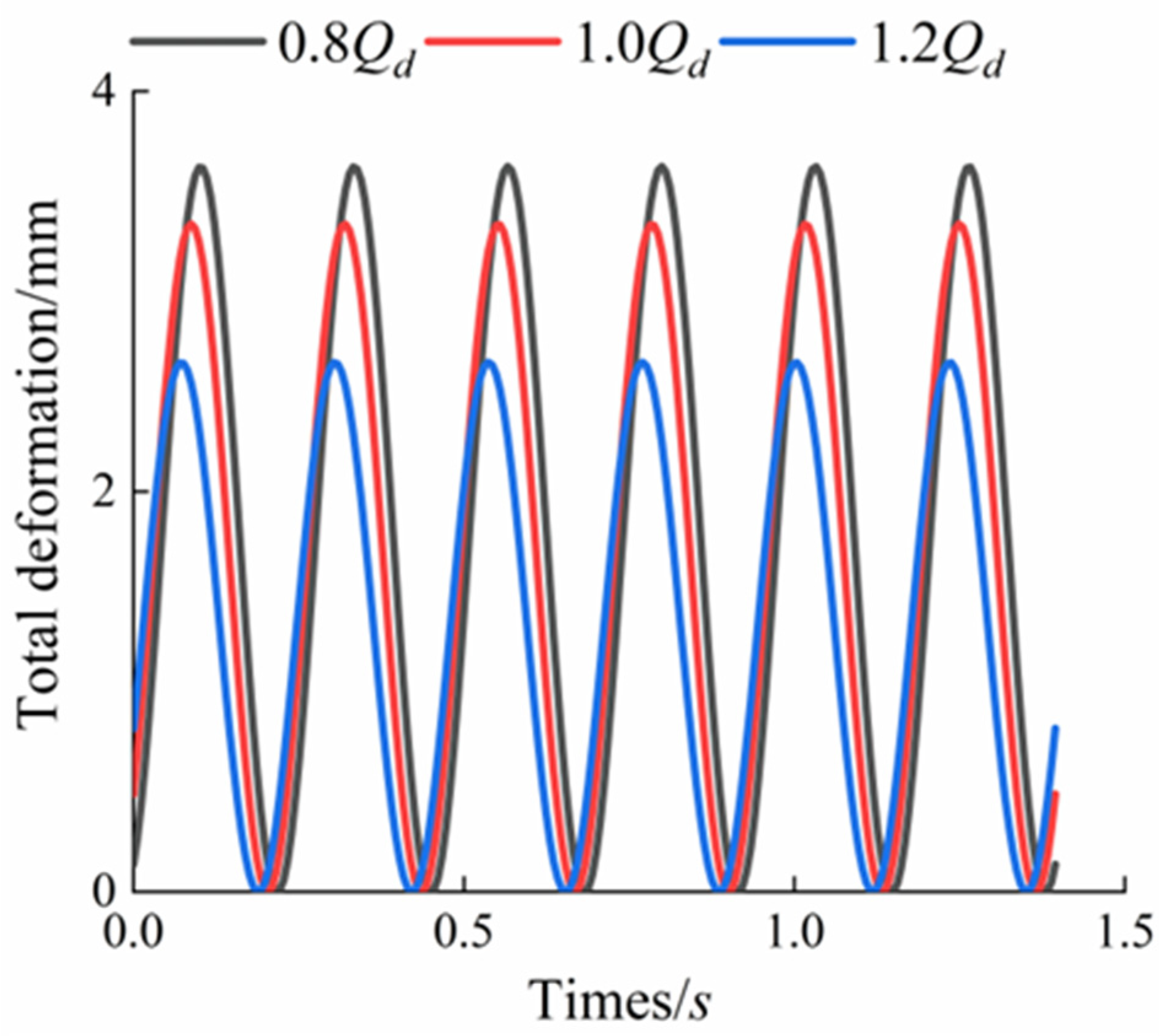





| Flow Passage Components | Geometric Parameters | Value |
|---|---|---|
| Impeller | Impeller outlet diameter | 4300 mm |
| Hub diameter | 1600 mm | |
| Hub ratio | 0.37 | |
| Number of blades | 3 | |
| Inlet diameter | 4520 mm | |
| Outlet diameter | 5520 mm | |
| Guide vane | Guide vane diffusion angle | 13.4° |
| Number of blades | 5 |
| Order | Pre-Stressed Air Inherent Mode/Hz | Wet Mode/Hz |
|---|---|---|
| First order | 22.019 | 19.204 |
| Second order | 22.029 | 19.210 |
| Third order | 39.536 | 32.753 |
| Fourth order | 62.447 | 50.394 |
| Fifth order | 62.45 | 50.401 |
| Sixth order | 71.804 | 58.721 |
Disclaimer/Publisher’s Note: The statements, opinions and data contained in all publications are solely those of the individual author(s) and contributor(s) and not of MDPI and/or the editor(s). MDPI and/or the editor(s) disclaim responsibility for any injury to people or property resulting from any ideas, methods, instructions or products referred to in the content. |
© 2024 by the authors. Licensee MDPI, Basel, Switzerland. This article is an open access article distributed under the terms and conditions of the Creative Commons Attribution (CC BY) license (https://creativecommons.org/licenses/by/4.0/).
Share and Cite
Wang, W.; Li, J.; Wu, C.; Pei, J.; Luo, C.; Hu, B. Study on the Structural Characteristics of Bulb Tubular Pumps Based on Fluid–Structure Interaction. Processes 2024, 12, 1641. https://doi.org/10.3390/pr12081641
Wang W, Li J, Wu C, Pei J, Luo C, Hu B. Study on the Structural Characteristics of Bulb Tubular Pumps Based on Fluid–Structure Interaction. Processes. 2024; 12(8):1641. https://doi.org/10.3390/pr12081641
Chicago/Turabian StyleWang, Wenjie, Jingyu Li, Chunhui Wu, Ji Pei, Can Luo, and Bo Hu. 2024. "Study on the Structural Characteristics of Bulb Tubular Pumps Based on Fluid–Structure Interaction" Processes 12, no. 8: 1641. https://doi.org/10.3390/pr12081641
APA StyleWang, W., Li, J., Wu, C., Pei, J., Luo, C., & Hu, B. (2024). Study on the Structural Characteristics of Bulb Tubular Pumps Based on Fluid–Structure Interaction. Processes, 12(8), 1641. https://doi.org/10.3390/pr12081641










